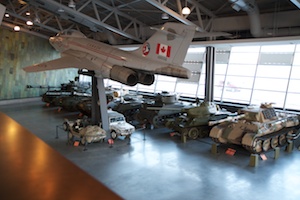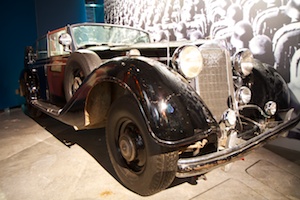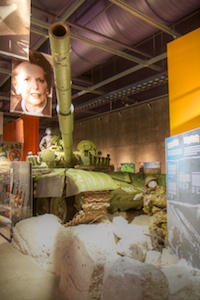Today I continued my monthly museum visits with my first visit to the new Canadian War Museum.
I had been to the older museum about a decade ago. The new building, which opened in 2005, is much nicer with more room for exhibits.

First, I took the ramp down to the LeBreton Gallery (the main display floor). The ramp is lined with huge paintings, but they are mounted so high up on the wall it distances the viewer from the works. I think the paintings should be lower and closer to the viewer so that they may be more engaged.
The LeBreton Gallery contains a large collection of military vehicles and other large hardware. It was focused more on the army; there was only a single plane and a few naval guns. There were dozens of vehicles. The main museum for aviation would be the Canadian Aviation and Science Museum, and the Navy is well represented by the Maritime Museum of the Atlantic in Halifax.
Of interest to me was the 40mm Bofors anti-aircraft naval guns. They were ubiquitous during the later stages of war in the Pacific. They were mounted en-mass on every naval ship. They were complemented by the smaller, close range 20mm singles. They were key to dealing with the ship protection until the introduction of the kamikaze threat in the later stages of the war required the new 3″ anti-aircraft gun.
Along the same row were the main battle tanks, including the famous World War II M-4 Sherman, Russian T-34 and the German Panzer MkII and Panzer V tanks. At the end of the row were the Cold War tanks like the Chieftain and Leopard I.
A CF-101 Voodoo was mounted high in the ceiling, as if flying over the battlefield.
Also on display in the LeBreton Gallery were a jumble of smaller vehicles, including motorcycles, snowmobiles, ambulances, artillery and so forth.
Next, I went upstairs to the exhibits. The layout was a little confusing; I had to use a map to find out where I should go.
The history of military in Canada starts long before Canada was a country. Before the Europeans arrived, tribes of First Nations would wage war against each other. Forts were built using wood an other available natural resources.
Once the Europeans arrived, there were wars between the French and British, culminating in the French defeat in Quebec City (Battle of the Plains of Abraham), the destruction of Fortress Louisbourg in Nova Scotia, and the deportation of the Acadians (Le Grand Dérangement).
Canadian troops participated, as part of the British Empire, in some of the African campaigns of the British at the turn of the 20th century.

Canada was first forged as a nation on the battlefields and trenches of World War I. Though a country with a small population, Canada contributed to the eventual success in the Western Front through gallantry and the use of new tactics.
The Second Battles of Ypres, where the Canadian troops were gassed by the Germans), was the first time a former colonial force pushed back a major European power, in this case the Germans. The Third Battle of Ypres ended when Canadian Troops captured Passchendaele. In the Battle of Sommes, the 1st Newfoundland Regiment was almost entirely wiped out in a single attempt to advance to the next line of Allied trenches. This was indicative of the murderous attrition rate of trench warfare.
At the Battle of Vimy Ridge, where “all four four divisions of the Canadian Expeditionary Force participated in a battle together, and thus became a Canadian nationalistic symbol of achievement and sacrifice”. Tactically, it was a brilliant victory for the Canadians. Using a rolling artillery barrage to keep the Germans undercover in their trenches, the Canadians were able to advance to their objectives without coming under attack from the withering machine gun fire.
In both World War I and II, a major part of the Canadian contribution was our navy. The first Battle of the Atlantic (WWI) and Second Battle of the Atlantic (WWII) against the German U-boat threat was important to Canada and also to the Allied European powers – United Kingdom and the Soviet Union.

Canada entered World War II in September 1939. Canada was a location for the training of troops, a strategic location for the transatlantic convoys, and a major military force for the liberation of Europe. In the World War II exhibit, the museum had a Spitfire flying overhead and Hitler’s 1933 Mercedes-Benz 700k staff car.
After the war, Canada was on the front lines of the Cold War with the Soviet Union. The Canadian Navy excelled in anti-submarine warfare and was a member of STANAVFORLANT, a NATO task force. Canada was between the two superpowers. Any nuclear war would see Canada stuck in the middle. The most important part of this history was the creation and later cancellation of the Avro CF-105 Arrow (the most advanced interceptor of the time) and the subsequent purchase of nuclear tipped BOMARC missiles for Canadian airspace protection (as part of the larger NORAD organization).

This part of the exhibition had a Soviet T-72 MBT and a MGR-1 Honest John short-range missile.
The final exhibit was Canada as peacekeeper. I am justly proud of the Canadian peacekeeping missions. We have earned our reputation in conflict zones in the Middle East, Africa and the Caribbean. If I were in a position to influence the future direction of the Canadian military, it would be to expand the peacekeeping missions and sovereign territory protection (cough, the Arctic Ocean, cough), at the expense of large-scale offensive military actions (i.e. NATO).
I had only a few minutes at the end of my visit to walk (nearly run) through the extensive art gallery. I really enjoyed seeing the wealth and variety of art pieces on display, which cover all the major combat areas and conflicts, up to and including the current mission in Afghanistan and our on-going peacekeeping missions. The museum closed as I was in the gallery section.
Overall, it was good to go through the museum, but I don’t know that there is much to draw me back for return visits.
Interesting research notes: Canada has the 13th largest defence budget ($21.8 billion Cdn), and 58th largest in terms of personnel (67,000).
The photo gallery for my visit is here: http://gallery.myredbmw.net/v/Events/WarMuseum/.
